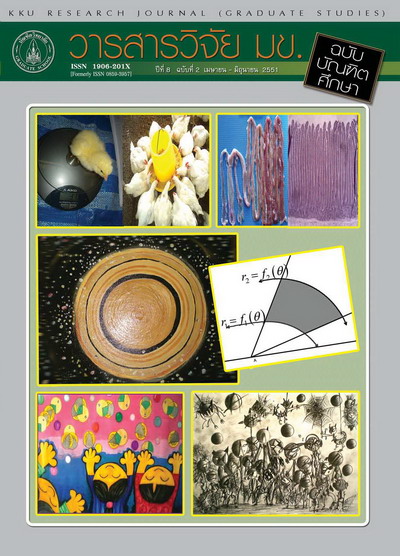Anti-Herpes Simplex Virus Type 1 Activity of Crude Ethyl Acetate Extract of Clinacanthus nutans(การศึกษาฤทธิ์การยับยั้งเชื้อเฮอร์ปีส์ ซิมเพล็กซ์ ไวรัส ไทป์ 1 ของสารสกัดเอทิลอะซิเตตจากสมุนไพรพญายอ)
Keywords:
Clinacanthus nutans Lindau (C. nutans L.)(พญายอ), Herpes simplex virus type 1(เชื้อไวรัวเฮอร์ปีส์ ชีมเพล็กซ์ไทป์1), Antiviral activity(ฤทธิ์การยับยั้งเชื้อไวรัส)Abstract
การทดสอบฤทธิ์ของสารสกัดเอทิลอะซิเตตจากพญายอในการยับยั้งเชื้อไวรัสเฮอร์ปีส์ ซิมเพล็กซ์ ไทป์ 1 (HSV-1) โดยวิธี plaque reduction assay พบว่าสารสกัดสมุนไพรความเข้มข้น < 19 µg/ml ไม่เป็นพิษต่อเซลล์ โดยความเข้มข้น 76 µg/ml มีความเป็นพิษต่อเซลล์ร้อยละ 50 ซึ่งที่ระดับความเข้มข้น 7.6 µg/ml สามารถยับยั้งการติดเชื้อร้อยละ 50 โดยมีค่า selectivity index ต่อเชื้อ HSV-1 เท่ากับ 10 เมื่อทำการศึกษาว่าสารสกัดมีผลยับยั้งไวรัสในระยะก่อน (pre-infection) หรือหลังเข้าสู่เซลล์ (post-infection) พบว่าในระยะก่อนเข้าเซลล์สารสกัดสามารถลดจำนวนกลุ่มเซลล์ที่ติดเชื้อได้ร้อยละ 97 เมื่อเทียบกับกลุ่มควบคุม ซึ่งผลการยับยั้งจะเพิ่มขึ้นตามช่วงเวลาในการทดสอบ ในขณะที่การทดสอบในระยะหลังเข้าสู่เซลล์ พบว่าสารสกัดไม่สามารถยับยั้งการเพิ่มจำนวนของไวรัสได้ ซึ่งการศึกษานี้แสดงให้เห็นว่าสารสกัดเอทิลอะซิเตตจากพญายอมีผลในการยับยั้งเชื้อ HSV-1 ในระยะก่อนที่เชื้อเข้าสู่เซลล์เพื่อให้ทราบกลไกการออกฤทธิ์ของสารสกัดที่แท้จริงควรศึกษากลไกการออกฤทธิ์ในระยะดังกล่าวในระดับโมเลกุลต่อไปCrude ethyl acetate of Clinancanthus nutans was investigated for its antiviral activity on herpes simplex virus type 1 (HSV-1) in vitro by using a plaque reduction assay. Results showed that the extract had no cytotoxic effect against Vero cell at concentration of 19 µg/ml or below and showed the 50% cytotoxic concentration (CC50) was 76 µg/ml. While the extract exhibited anti-herpestic activity with Crude ethyl acetate of Clinancanthus nutans was investigated for its antiviral activity on herpes simplex virus type 1 (HSV-1) in vitro by using a plaque reduction assay. Results showed that the extract had no cytotoxic effect against Vero cell at concentration of 19 µg/ml or below and showed the 50% cytotoxic concentration (CC50) was 76 µg/ml. While the extract exhibited anti-herpestic activity with



